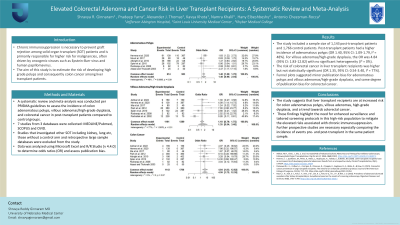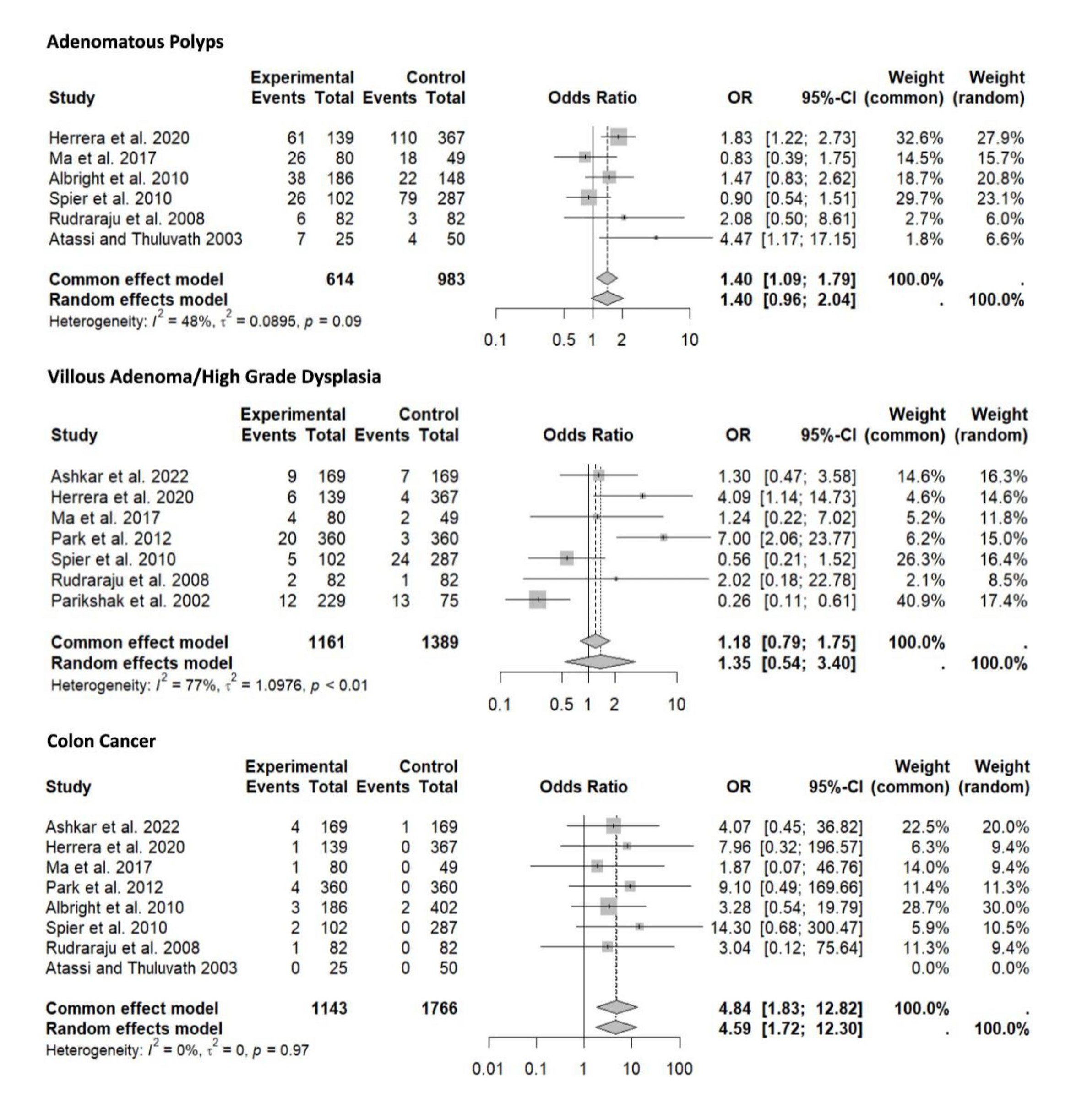Monday Poster Session
Category: Colon
P1926 - Elevated Colorectal Adenoma and Cancer Risk in Liver Transplant Recipients: A Systematic Review and Meta-Analysis
Monday, October 28, 2024
10:30 AM - 4:00 PM ET
Location: Exhibit Hall E

Has Audio

Shravya Ginnaram, MD
Jefferson Abington Hospital
Willow Grove, PA
Presenting Author(s)
Shravya Ginnaram, MD1, Pradeep Yarra, MD2, Alexander J. Thomas, MD3, Kavya Khota, MD4, Namra Khalil, MBBS5, Hany Elbeshbeshy, MD2, Antonio R. Cheesman, MD3
1Jefferson Abington Hospital, Willow Grove, PA; 2Saint Louis University School of Medicine, St. Louis, MO; 3SSM Health Saint Louis University Hospital, St. Louis, MO; 4Jefferson Abington Hospital, Abington, PA; 5Khyber Medical College, Peshawar, Pakistan, Horsham, PA
Introduction: Chronic immunosuppression is necessary to prevent graft rejection among solid organ transplant (SOT) patients and is primarily responsible for higher risk for malignancies, often driven by oncogenic viruses such as Epstein-Barr virus and human papillomavirus. The aim of this study is to estimate the risk of developing high grade polyps and consequently colon cancer among liver transplant patients.
Methods: A systematic review and meta-analysis was conducted per PRISMA guidelines to assess the incidence of colon adenomatous polyps, villous adenomas/high-grade dysplasia, and colorectal cancer in post-transplant patients compared to control groups. 7 studies from 3 databases were collected: MEDLINE/Pubmed, SCOPUS and OVID. Studies that investigated other SOT including kidney, lung etc, those without a control arm and retrospective large sample databases were excluded from the study. Data was analyzed using Microsoft Excel and R/R Studio [v 4.4.0] to determine odds ratios (OR) and assess publication bias.
Results: The study included a sample size of 1,143 post-transplant patients and 1,766 control patients. Post-transplant patients had a higher incidence of adenomatous polyps (OR 1.40, 95% CI: 1.09-1.79, I² = 48%). For villous adenomas/high-grade dysplasia, the OR was 4.84 (95% CI: 1.83-12.82) with no significant heterogeneity (I² = 0%). The risk of colorectal cancer in liver transplant recipients was higher but not statistically significant (OR 1.35, 95% CI: 0.54-3.40, I² = 77%). Funnel plots suggested minor publication bias for adenomatous polyps and villous adenomas/high-grade dysplasia, and some degree of publication bias for colorectal cancer.
Discussion: The study suggests that liver transplant recipients are at increased risk for colon adenomatous polyps, villous adenomas, high-grade dysplasia, and a trend towards colorectal cancer. These findings highlight the need for enhanced surveillance and tailored screening protocols in this high-risk population to mitigate the elevated risks associated with chronic immunosuppression. Further prospective studies are necessary especially comparing the incidence of events pre- and post-transplant in the same patient sample.

Disclosures:
Shravya Ginnaram, MD1, Pradeep Yarra, MD2, Alexander J. Thomas, MD3, Kavya Khota, MD4, Namra Khalil, MBBS5, Hany Elbeshbeshy, MD2, Antonio R. Cheesman, MD3. P1926 - Elevated Colorectal Adenoma and Cancer Risk in Liver Transplant Recipients: A Systematic Review and Meta-Analysis, ACG 2024 Annual Scientific Meeting Abstracts. Philadelphia, PA: American College of Gastroenterology.
1Jefferson Abington Hospital, Willow Grove, PA; 2Saint Louis University School of Medicine, St. Louis, MO; 3SSM Health Saint Louis University Hospital, St. Louis, MO; 4Jefferson Abington Hospital, Abington, PA; 5Khyber Medical College, Peshawar, Pakistan, Horsham, PA
Introduction: Chronic immunosuppression is necessary to prevent graft rejection among solid organ transplant (SOT) patients and is primarily responsible for higher risk for malignancies, often driven by oncogenic viruses such as Epstein-Barr virus and human papillomavirus. The aim of this study is to estimate the risk of developing high grade polyps and consequently colon cancer among liver transplant patients.
Methods: A systematic review and meta-analysis was conducted per PRISMA guidelines to assess the incidence of colon adenomatous polyps, villous adenomas/high-grade dysplasia, and colorectal cancer in post-transplant patients compared to control groups. 7 studies from 3 databases were collected: MEDLINE/Pubmed, SCOPUS and OVID. Studies that investigated other SOT including kidney, lung etc, those without a control arm and retrospective large sample databases were excluded from the study. Data was analyzed using Microsoft Excel and R/R Studio [v 4.4.0] to determine odds ratios (OR) and assess publication bias.
Results: The study included a sample size of 1,143 post-transplant patients and 1,766 control patients. Post-transplant patients had a higher incidence of adenomatous polyps (OR 1.40, 95% CI: 1.09-1.79, I² = 48%). For villous adenomas/high-grade dysplasia, the OR was 4.84 (95% CI: 1.83-12.82) with no significant heterogeneity (I² = 0%). The risk of colorectal cancer in liver transplant recipients was higher but not statistically significant (OR 1.35, 95% CI: 0.54-3.40, I² = 77%). Funnel plots suggested minor publication bias for adenomatous polyps and villous adenomas/high-grade dysplasia, and some degree of publication bias for colorectal cancer.
Discussion: The study suggests that liver transplant recipients are at increased risk for colon adenomatous polyps, villous adenomas, high-grade dysplasia, and a trend towards colorectal cancer. These findings highlight the need for enhanced surveillance and tailored screening protocols in this high-risk population to mitigate the elevated risks associated with chronic immunosuppression. Further prospective studies are necessary especially comparing the incidence of events pre- and post-transplant in the same patient sample.

Figure: Forest Plots Comparing Risk of Developing Colon Adenomatous Polyps, Villous Adenoma/High Grade Dysplasia and Cancer Among Liver Transplant Recipients
Disclosures:
Shravya Ginnaram indicated no relevant financial relationships.
Pradeep Yarra indicated no relevant financial relationships.
Alexander Thomas indicated no relevant financial relationships.
Kavya Khota indicated no relevant financial relationships.
Namra Khalil indicated no relevant financial relationships.
Hany Elbeshbeshy: AbbVie – Grant/Research Support, Honorarium. CymaBay, a Gilead Sciences Company – Grant/Research Support, Honorarium. Eisai – Grant/Research Support, Honorarium. Fibronostics – Grant/Research Support, Honorarium. Genfit – Grant/Research Support, Honorarium. Gilead Sciences, Inc. – Grant/Research Support, Honorarium. Intercept – Grant/Research Support, Honorarium. Mallinkrodt – Grant/Research Support, Honorarium.
Antonio Cheesman indicated no relevant financial relationships.
Shravya Ginnaram, MD1, Pradeep Yarra, MD2, Alexander J. Thomas, MD3, Kavya Khota, MD4, Namra Khalil, MBBS5, Hany Elbeshbeshy, MD2, Antonio R. Cheesman, MD3. P1926 - Elevated Colorectal Adenoma and Cancer Risk in Liver Transplant Recipients: A Systematic Review and Meta-Analysis, ACG 2024 Annual Scientific Meeting Abstracts. Philadelphia, PA: American College of Gastroenterology.
